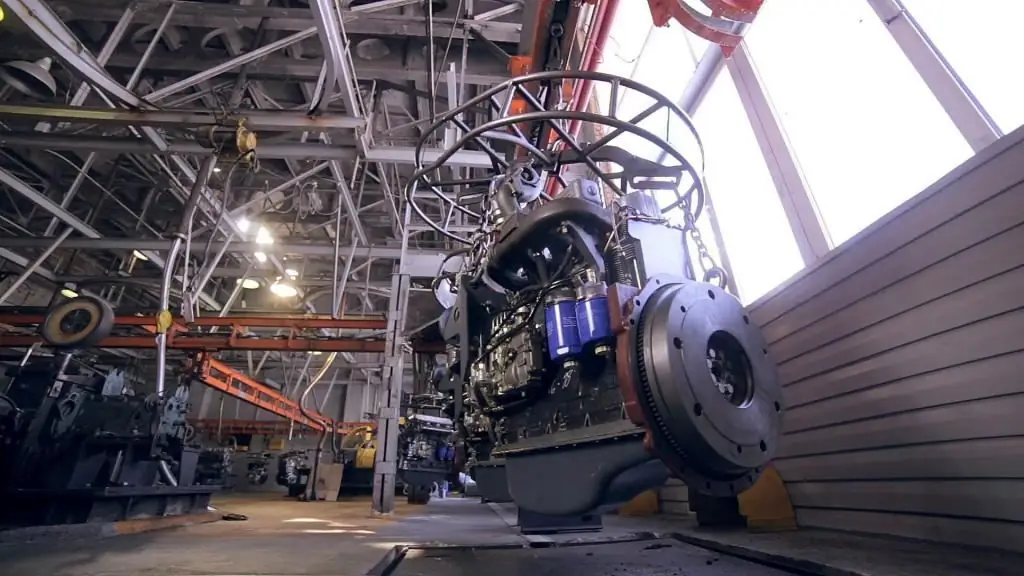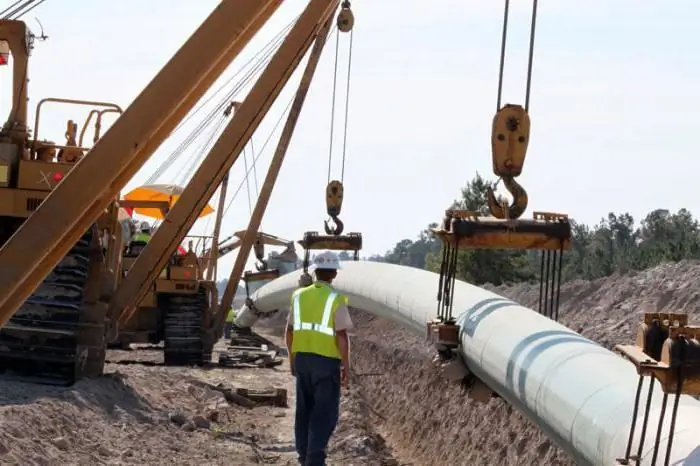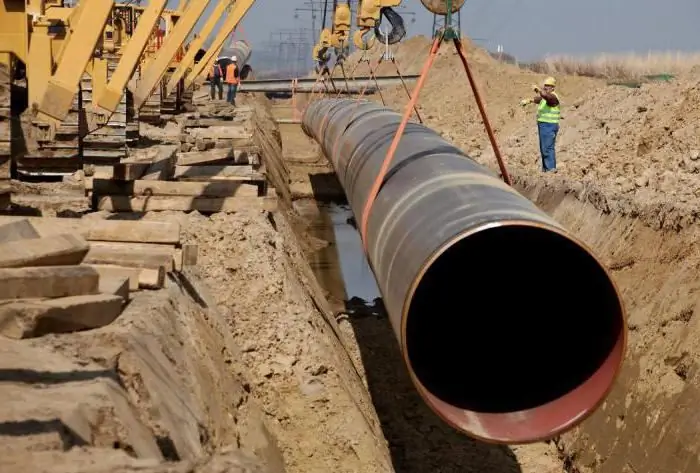2026 Author: Howard Calhoun | [email protected]. Last modified: 2025-06-01 07:12:56
The main gas pipeline "Krasnodar Territory - Crimea" began to operate in December 2016 in order to provide fuel to the main power plants of the peninsula, located in the cities of Simferopol and Sevastopol. The gas pipeline is designed to ensure reliable and stable operation of the gas transmission system on the Crimean Peninsula, which requires serious reconstruction due to small volumes of gas production and the use of outdated facilities.
Prerequisites for the construction of the gas pipeline

In the autumn of 2015, the residents of Crimea faced a serious problem of lack of electricity, as Ukrainian-Tatar activists blew up several power pylons going to the peninsula. Only thanks to good weather and the construction of an underwater energy bridge to the Crimea from the Kuban, the peninsula managed to avoid many problems. An equally difficult situation arose in the gas transmission system.
Crimea at the time of joining Russia produced about 2 billion cubic meters per year. m of gas with domestic consumption of 1.6 billion cubic meters. m. Ifevaluate these data, there were no visible problems on the peninsula.
However, the Crimean gas industry has a number of features. In particular, it is typical for Crimea to consume gas unevenly, that is, in summer, consumption can be 2 million cubic meters per day. m, and in the heating season - 10-13 million cubic meters. In addition, gas consumption on the peninsula has increased due to problems with electricity.
As for gas production, it cannot be changed dramatically: reduced or, conversely, increased depending on the time of year and the needs of the territory. To ensure that there is enough gas for the winter season, there is the Glebovskoye gas storage in Crimea, the active volume of which is 1 billion cubic meters. m. But now it is not fully used. In addition, in order to increase gas production, it is necessary to carry out additional drilling and install booster equipment. Currently, the amount of gas produced offshore is falling. So, for the period 2014-2015. it fell to 1.8 billion cubic meters. m.
Another important nuance: the settlement of shelf problems with Ukraine. The most powerful and promising offshore gas field is Odessa. It is located much closer to the coast of Odessa than to the Crimean peninsula, which means that Ukraine has more rights to it. This field began to be exploited shortly before the secession of Crimea, and without its resources it would be difficult for the peninsula to cope with the gas problem, because it provides approximately 60% of all gas produced in Crimea.
These factors led to the need to revise the timing and plans for constructiongas pipeline, as it was originally planned to complete the gas pipeline to the Crimea by the end of 2017, along with the construction of two powerful gas blocks of thermal power plants in Sevastopol and Simferopol.
The importance of the gas pipeline to Crimea

The construction of a gas pipeline in the Crimea is an objective necessity. This will improve the gas supply to the peninsula and, in particular, to its most complex settlements - Sevastopol and Kerch. In addition, this will help improve the reliability of the Crimean gas transmission system. The main task of the construction is to ensure the energy security of Crimea.
Crimean gasification will be of great importance for the Kuban economy. The construction of the gas pipeline will bring additional revenues to the budget of the Krasnodar Territory, and will also help reduce unemployment. The growth of tax revenues will primarily be due to the imposition of a real estate tax on infrastructure facilities. There was a lot of controversy regarding the environmental component of the project, namely, whether the construction of the gas pipeline would lead to a deterioration in the ecology of Lake Tuzla and the Kerch Strait, but experts say that no negative environmental consequences should be expected. In addition, the construction of the gas pipeline will increase the attractiveness of the Krasnodar Territory for investors. Also, the filling of the regional budget will be facilitated by transit deductions.
Krasnodar Territory - Crimea Gas Pipeline: Key Features
They are:
- responsibility level 1a;
- protection against seismic activity 7-9 points;
- minimum service life of 50 years;
- supply capacity - up to 4 bcm m/year;
- maximum pressure - 75 kgf;
- pipe diameter 500-700mm.
Project features

The main gas pipeline is designed to provide gas to two Crimean thermal power plants with a capacity of 380 MW each. This will fully cover the electricity needs of the peninsula.
The gas pipeline to the Crimea runs from the Yuzhnaya station along the bottom of the Kerch Strait, first to Simferopol, and then to Sevastopol. The gas pipeline runs through different terrain, so pipes of different diameters were required for its construction.
The gas pipeline combines underground and underwater installation. The design of the gas pipeline was carried out taking into account one important point - providing protection against seismic activity of 7-9 points.
Design and survey work (R&D) for the installation of the gas pipeline was carried out by the Crimean Institute "Shelf". The design of the gas pipeline required significant financial investments. The amount was 149.833 million rubles.
Gas pipeline installation

The main installation work was entrusted to the specialists of the Stroygazmontazh company. Crimean companies were also involved in the work on the project.
The 400 km gas pipeline was built in three phases:
- land section 1.2 km long, running through the territory of the Taman Peninsula;
- section passingthrough the Kerch Strait, two branches, 16 km long: main and reserve;
- a land section, about 20.4 km long, running through the territory of the Kerch Peninsula.
Construction of the gas pipeline

The construction of the gas pipeline was carried out at an accelerated pace. On October 1, 2015, 200 km of pipes were purchased, and in the spring of 2016, the gas pipeline to Crimea was already 30% ready.
In March 2016, the approval of all the necessary documentation for the project by the Glavgosexpertiza of the Russian Federation for the Kuban-Crimea section was completed, and in May for the Crimean part of the gas pipeline.
By September 2016, the work was already done by 90%. In November 2016, Crimea again resumed gas supplies to the Ukrainian city of Genichesk, which had been experiencing a gas shortage all this time. Since the construction of the gas pipeline was almost completed, it was decided to resume supplies.
The completion of construction and the commissioning of the finished gas pipeline took place on December 27, 2016.
Project financing

Financing of the gas pipeline construction project was carried out at the expense of the state budget of the Russian Federation. The implementation required about 20 billion rubles, of which 14 billion rubles. were used to purchase materials needed for the construction and installation of the gas pipeline.
Timing
Initially, the completion of the construction of the gas pipeline from the Kuban to the Crimea was planned for December 2017. But in connection withdecrease in gas production in the Crimea and a sharp increase in its consumption, the timing was shifted. The gas pipeline was put into operation a year earlier.
Gas pipeline opening

The gas pipeline to the Crimea from Russia was completed much ahead of schedule. On December 27, 2016, Russian President Vladimir Putin launched gas through it.
The total length was 358.7 km. In total, the installation of the gas pipeline was carried out by 1200 people, 460 technical units, 40 ships.
Further plans
On the basis of the new gas pipeline, it is planned to build two power plants that will fully meet the needs of the Crimea for electricity. Completion of construction of power plants is scheduled for 2018.
Energymen also plan to build new and reconstruct old main gas pipelines with a total length of 70 km, as well as 2,500 km of inter-settlement Crimean gas pipelines. In addition, eight additional gas pumping stations are going to be built in Crimea.
Thus, the construction of a gas pipeline to the Crimea was an objective necessity. The gas transportation system of the peninsula was in a critical situation, since in the winter of 2016 the peninsula could not provide its consumers with gas in sufficient quantities on its own. A decrease in the amount of gas produced offshore, as well as an increase in consumption on the peninsula, led to the need to speed up the construction time. As a result, the gas pipeline was put into operation a year earlier - in December 2016. Accelerationthe construction of the gas pipeline made it possible to remove restrictions for the thermal power plants of the peninsula and they were again transferred from fuel oil to gas.
The gas pipeline to Crimea will further bring the peninsula closer to the Russian mainland. Putting the project into operation, taking into account the decrease in the reserves of the Glebovskoye gas storage facility and the decrease in own production, will add about 13 million cubic meters. m of gas per day. This should be sufficient even if the winter months are very cold. But still with a small margin of safety. However, according to forecasts for new gas thermal power plants, this volume will not be enough. By the end of 2017, the construction of the second branch of the gas pipeline is planned, as well as the reconstruction of the Glebovsky gas storage facility, as a result of which its capacity will double (if the reconstruction is carried out in accordance with the Ukrainian plan), or even four times. This will finally solve all the existing problems with the gas transmission system in the Russian Crimea, even taking into account the further growth in gas consumption and an even greater decrease in Crimean gas production.
However, it is worth noting that Genichesk will continue to depend on Crimean gas supplies, since no measures have been taken by the Ukrainian authorities to solve this problem for a year. They only recommended citizens to install alternative heating options. In the current situation, thanks to the construction of a gas pipeline from the mainland of the Russian Federation to the Crimea, this will not be a problem for the peninsula.
Recommended:
Large companies of Krasnodar and the Krasnodar Territory

Krasnodar Territory is considered the center of domestic agriculture, and almost no one knows about the industrial power of the region, which is completely unfair. In our material, we will talk about the largest companies in Krasnodar in the field of industry and production
Gas pipeline to China. Project and scheme of a gas pipeline to China

Russia and China have signed a long-awaited gas contract. To whom is it beneficial? Will the fact of its signing affect the geopolitical situation?
С-400. ZRK S-400 "Triumph". S-400, missile system

In recent years, in the armies of the whole world, the emphasis is on means that allow you to destroy the enemy and enemy equipment at a distance, avoiding a direct collision. Domestic aircraft are no exception. Old missile systems are being modernized, new ones are being created
Main pipe for gas pipeline

Today it is difficult to imagine the world and one's own life without the achievements of science and technology. Many people think that the main achievement is information development, but just imagine your life without industrial facilities! In everyday life, everyone uses the benefits of civilization: water, electricity, gas, heat, and can no longer imagine their comfortable life without them. In order to deliver water and gas, water and gas pipelines are being built, which act as a vehicle
Laying a gas pipeline: methods, equipment, requirements. Gas pipeline security zone

Laying of the gas pipeline can be done by underground and ground methods. When choosing equipment for such systems, safety standards should be followed. Actually, the laying of highways is carried out with strict observance of all the required technologies

